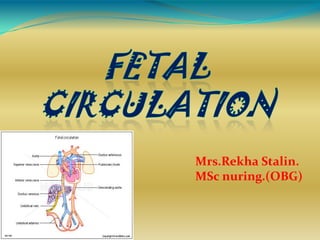
Fetal circulation
- 2. DEFINITION The fetal circulation is the circulatory system of a human fetus, often encompassing the entire fetoplacental circulation which includes the umbilical cord and the blood vessels within the placenta that carry fetal blood.
- 3. PATHWAY Placenta Umbilical Vein Umbilical Arteries Liver Ductus Venosus Inferior Venacava Right Atrium Foramen Ovale Right Lung Arch of Aoarta Ductus Arteriosus Left Atrium Left Ventricle Right Ventricle Portal Vein
- 4. Umbilical Cord 2umbilical arteries: return non-oxygenated blood, fecal waste, CO2 to placenta 1umbilical vein: brings oxygenated blood and nutrients to the fetus
- 5. Three shunts are present in fetal life: 1. Ductus venosus: connects the umbilical vein to the inferior vena cava 2. Ductus arteriosus: connects the main pulmonary artery to the aorta 3. Foramen ovale: anatomic opening between the right and left atrium.
- 6. PATHWAY Oxygenated blood from the placenta through umbilical vein fetus liver Receives deoxygenated blood from the portal vein through ductus venosus Inferior vena cava Right atrium of heart through foramen ovale Left atrium of the heart Left ventricle of the heart
- 7. During ventricular systole Left ventricular blood Right ventricular blood pumped with < o2 content Ascending aorta and distributed is discharged by their branches to the heart, Pulmonary arteries head,neck,brain,arms. Ductus arteriosus Descending aorta Hypogastric arteries Umbilical arteries Placenta
- 8. During fetal life 350ml per kg per min Cardiac Output Following birth 500ml per min Heart Rate 120-140per min
- 9. At birth Clamping the cord shuts down low-pressure system Increased atmospheric pressure(increased systemic vascular resistance) causes lungs to inflate with oxygen Lungs now become a low-pressure system
- 11. Changes in the Fetal Circulation after birth Umbilical arteries → Umbilical ligaments Umbilical vein → Ligamentum teres Shunt Functional closure Anatomical closure Remnant Ductus arteriosus 10 – 96 hrs after birth 2 – 3 wks after birth Ligamentum arteriosum Formamen ovale Within several mins after birth One year after birth Fossa ovalis Ductus venosus Within several mins after birth 3 – 7 days after birth Ligamentum venosum
- 12. Fetal Vs Infant Circulation Fetal Infant • Low pressure system • Right to left shunting • Lungs non-functional • Increased pulmonary resistance • Decreased systemic resistance •High pressure system •Left to right blood flow •Lungs functional •Decreased pulmonary resistance •Increased systemic resistance
